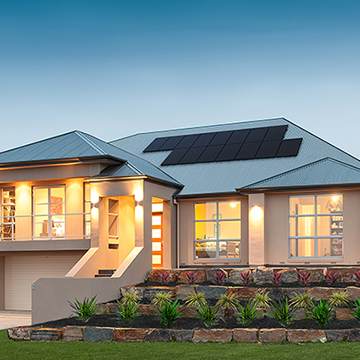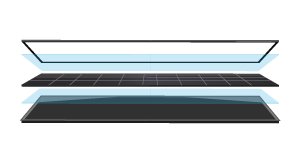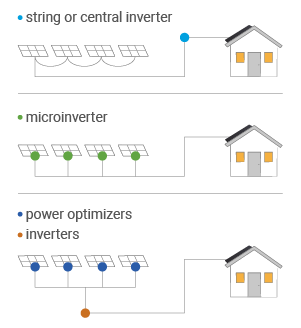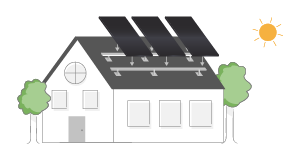Solar 101: solar power systems explained
Ever since 1954, when scientists at Bell Telephone discovered that silicon–an element found in sand–created an electric charge when exposed to sunlight, solar technology has evolved and been adopted by more than 2 million homes throughout the country. Today, solar panel systems provide a very attractive option to homes and businesses as a clean, affordable energy choice.

Solar panel systems: the basics
Thanks to the development of solar panels, we can harness the energy of an inexhaustible source of power–the sun. Solar panel systems work very simply:
- During the day, solar cells in your solar panels absorb the energy from sunlight;
- Circuits within the cells collect that energy and turn it into direct current (DC) energy;
- The DC electricity is passed through a device called an inverter to convert it to the usable alternating current (AC) electricity that comes out of your wall outlets;
- All of which means you can use that electricity in your home, store it with a solar battery, or send it back to the grid.
Below, we’ll run through a quick overview of solar panel systems, as well as the equipment that you’ll need to produce power using the sun. Already an expert on how solar equipment works? Great! Check out the next pieces in our Solar 101 section, or head to the next section to learn about the benefits of solar.
What is a solar panel?
A solar panel is a device that collects sunlight and turns it into usable electricity. Solar panels are usually made of solar cells (made from the element silicon), wiring, a metal frame, and a glass cover. A typical solar panel is about four feet wide, and six feet tall.
What components make up a solar panel system?
Solar panel installations are very straightforward systems. There are only four main components to any solar panel system, and no moving parts, making them very efficient to install and maintain. The four components of a solar panel system are:
- Solar photovoltaic panels–to convert solar energy into electricity
- Inverters–to convert DC electricity into AC electricity
- Racking and mounting systems–to affix your solar panels to your roof (or to the ground, depending upon your installation type)
- Performance monitoring systems–to track and monitor the output and health of your solar panels and inverters
Solar Panels
Solar Panels consist of a series of silicon solar cells covered by a sheet of glass and held together by a metal frame, with wiring and circuitry in and behind the cells to collect the flow of electrical current out of the solar cells. Each solar panel, also referred to as a solar module, is typically about 4 feet by 6 feet in size, and weighs approximately 30 pounds.

Inverters
The cells in your solar panels collect the sun’s energy and turn it into direct current (DC) electricity. Most homes and businesses, however, use alternating current (AC). Inverters change the DC electricity from your panels into usable AC electricity. There are two basic types of solar inverters: string (or centralized) inverters and microinverters. String inverters can also add power optimizers to function similarly to a microinverter system.

String (or centralized) inverter: A single inverter connects your entire array of solar panels to your electrical panel. String inverters are frequently the least expensive inverter option, and are a very durable technology that have historically been the most commonly installed inverter type. Multiple strings of panels can be connected to each inverter; however, if the electricity production from one of the panels in a string drops (as may happen due to shading), it can temporarily reduce the performance of that whole string. And because of this, Helio Solar Power does not use this type of inverter method.
Microinverters: Microinverters are installed at each solar panel, which allows each panel to maximize production. If some of your panels are shaded at different times of day or if they aren’t all installed facing the same direction, microinverters will minimize performance issues.
Power optimizers: Systems that use power optimizers are a hybrid of micro-inverter and string inverter systems. Like microinverters, power optimizers are installed at each panel. However, instead of converting the DC electricity from the solar panels into AC electricity, the optimizers “condition” the DC electricity before sending it to a centralized inverter. Like microinverters, they perform well when one or more panels are shaded or if panels are installed facing different directions.
String (or centralized) inverter: A single inverter connects your entire array of solar panels to your electrical panel. String inverters are frequently the least expensive inverter option, and are a very durable technology that have historically been the most commonly installed inverter type. Multiple strings of panels can be connected to each inverter; however, if the electricity production from one of the panels in a string drops (as may happen due to shading), it can temporarily reduce the performance of that whole string. And because of this, Helio Solar Power does not use this type of inverter method.
Microinverters: Microinverters are installed at each solar panel, which allows each panel to maximize production. If some of your panels are shaded at different times of day or if they aren’t all installed facing the same direction, microinverters will minimize performance issues.
Power optimizers: Systems that use power optimizers are a hybrid of micro-inverter and string inverter systems. Like microinverters, power optimizers are installed at each panel. However, instead of converting the DC electricity from the solar panels into AC electricity, the optimizers “condition” the DC electricity before sending it to a centralized inverter. Like microinverters, they perform well when one or more panels are shaded or if panels are installed facing different directions.
Racking and mounting systems
Solar racking and mounting systems are the pieces of hardware that affix your solar panels to your roof or to the ground.

To perform at their best, solar panels should face south and be installed at an angle between 30 and 45 degrees (depending on how far you are from the equator). Panels facing east or west and at a pitch angle of five degrees or more will still work well, but will produce 10 to 20 percent less electricity than those installed under ideal conditions. For residential solar, most roof-mounted systems are “lie-flat” systems, which means the pitch of your solar panels parallels the pitch of your roof. In some cases, though, you can use racking to tilt or position your panels at an angle that is best for capturing the sun’s rays.
There are two types of mounts: fixed mounts, in which the panels remain stationary, and tracking mounts, which allow panels to “follow” the sun as it moves across the sky during the day (single-axis track mounts) and during the changing seasons (dual-axis track mounts). Tracker mounts are only suitable for ground mount solar.
Performance monitoring systems
Performance monitoring systems provide you with detailed information about the performance of your solar panel system. With a monitoring system, you can measure and track the amount of electricity your system produces on an hourly basis.

All of our inverters come with a production monitoring app so that you can track the output of your panels. This app will also provide consumption monitoring to help you track the overall savings from your solar panel system. Note: this additional consumption monitoring is only available with Sunnova Service Warranty.
Monitoring your solar panel system can help you to identify any performance issues to help ensure that you maximize the electricity production–and financial returns!–of your solar panel system.
There are two primary types of monitoring systems:
- On-site monitoring: The monitoring device is physically located on your property and records the amount of electricity produced.
- Remote monitoring: Your solar PV system transmits its performance data to a monitoring service that you can access online or with a mobile device.

